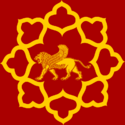Shirkal: Difference between revisions
No edit summary |
No edit summary |
||
| Line 327: | Line 327: | ||
The Azban (''Sawan'' in {{wp|Khwarezmian language|Skadian}}, ''Zicat'' in Sayari. Lit. "From Glory") conquered Shirkal in 310 BC. An altar was dedicated to the Azbanid ruler [[Azkajwar Anosh]], "Azkajwar the Immortal", by the inhabitants of Shirkal as celebration for Azkajwar' unexpected sparing of the city. A copy of the dedication, destroyed sometime during the 12th century, is still visible today in the Great Mithraeum. | The Azban (''Sawan'' in {{wp|Khwarezmian language|Skadian}}, ''Zicat'' in Sayari. Lit. "From Glory") conquered Shirkal in 310 BC. An altar was dedicated to the Azbanid ruler [[Azkajwar Anosh]], "Azkajwar the Immortal", by the inhabitants of Shirkal as celebration for Azkajwar' unexpected sparing of the city. A copy of the dedication, destroyed sometime during the 12th century, is still visible today in the Great Mithraeum. | ||
==Culture== | |||
===Cuisine=== | |||
[[File:Samarqand noni.jpg|200px|thumb|Bread of Shirkal.]] | |||
Shirkal is reputed as the culinary heart of Shirazam, the junction between the Great Rivers and their valleys where wheat is the dominant cereal and the Green Delta where rice is the most cultivated one. As such, it present a wide array of dishes and meals using ingredients from all across Shirazam. | |||
Symbolic of Shirkal is its bread. It's a kind of {{wp|Tandyr nan}}, a category of bread that take its name from the oven in which it is cooked: the {{wp|Tandoor}}, a large vase-shaped {{wp|clay oven}}. The Shirkalese ''Tanur'' is fully overground and its relatively small size make it easy to transport. It is circular and leavened with yeast, whereas most {{wp|Tandoor bread}}s are not, and typically has a crisp golden surface. Each bakery has its own stamp which are used to both decorate the bread and signal its origin. While ''Tanur Nan'' are cooked throughout Shirazam, in Shirkal they add milk, butter and honey to the base ingredient (flour, water, and yeast). Some bakers also add egg yolk to their recipe, giving their Nan a quality closer to a {{wp|Brioche}}-like pastry. A number of superstition surround Shirkal's bread: it must not be laid upside down, nor can anything be stacked on top of it except another Nan bread. It should not be cut with a knife instead it is the responsibility of the host to break the bread by hand. | |||
The main dish of Shirkaleses is the {{wp|Pilaf|Pulaw}}, a rice-based dish where the grains are {{wp|Simmering|simmered}} in a rich stew of meat and vegetables until all the liquid has been absorbed. It is generally cooked in a {{wp|Kazan (cookware)|Deghi}}, a large cooking pot similar to a {{wp|Dutch oven}}. | |||
[[category:Shirazam]] | [[category:Shirazam]] | ||
Revision as of 20:28, 28 October 2024
This article is incomplete because it is pending further input from participants, or it is a work-in-progress by one author. Please comment on this article's talk page to share your input, comments and questions. Note: To contribute to this article, you may need to seek help from the author(s) of this page. |
Shirkal | |
|---|---|
 Clockwise, from the top right: The Azayr Towers, the House of Deputies, the Seven Stars Plaza, the Grand Mithraeum, the Skadanshah-Kala Outer Walls, and a night view of the city as seen from the Citadel. | |
| Nickname: Lion's Fortress | |
| Country | |
| Area | |
| • District | 47.87 km2 (18.48 sq mi) |
| • Urban | 1,141.4 km2 (440.7 sq mi) |
| • Metro | 4,605.8 km2 (1,778.3 sq mi) |
| Elevation | 137 m (449 ft) |
| Highest elevation | 305 m (1,001 ft) |
| Lowest elevation | 67 m (220 ft) |
| Population (2024) | |
| • District | 522,224 |
| • Density | 11,000/km2 (28,000/sq mi) |
| • Urban | 1,702,771 |
| • Urban density | 1,500/km2 (3,900/sq mi) |
Shirkal is the capital of Shirazam. With a population of 500,000 people, and 1,7 million people within its Urban area, It is the country's largest city as well. Despite historically being a city (Xer), Shirkal is administratively categorized as its own District (Bax) with special prerogatives. It is one of three such "Urban District" (Xerak Bax) within Shirazam with Skandar and Tabruz as the other two. It is located at the confluent of the Great Rivers: the Sin-Darya and the Bozorg-Darya and controls the entrance to the Sabsagusha, the "Green Delta" which is the economic and demographic heart of Shirazam.
History
Kingdom of Skadia
Bardyia of Chirasmia was the Satrap and ruler of his home-province, corresponding roughly to modern Shirazam when Alcaeus XI the Azagartian Emperor, was overthrown by Mithridates II in 566 BC. during the crisis, Bardyia stopped delivering tributes to the throne and took the title of Skadanshah, King of the Skadians, possibly in the aftermath of a victory against the Sayareses nomads. Bardyia oversaw the construction and completion of the Fifty Fortresses of Shirazam, a network of fortification meant to protect the Green Delta and the fertile shores of the Great Rivers. One of the Fifty Fortresses was Shir-Kala, the "Lion's Fortress". The Skadian Kings did not have a single capital and regularly moved from palace to palace depending on the military or administrative necessities. The Kingdom of Skadia lasted around 60 years until it was reconquered by the Mithridatid Artaxerses II between 505 and 500 BC. Three Kings of the Skadians are known: Bardyia, Chosroes/Khosrow, and Ormisdas. Their relationships and the exact dates of their reigns are unknown although Ormisdas was King during the Mithridatid reconquest and is said to have been a teenager.
Archeological studies of this era are especially difficult in Shirkal to the continuous occupation of the site and the modern high density of inhabitants. Nonetheless, ruins and archeological artefacts are regularly found during construction works, mainly in the form of pottery shards. But the main fortress, the Skadanshah-Kal, still remain to this date albeit heavily altered by two millenium of use, expansion, destruction and reconstruction. A large section of the fortress' outer wall has notably been opened during the 15th century to build gardens, on top of which the House of Deputies now stand.
Only one more Azagartian Satrap, Mithridates, is known in Chirasmia following the reconquest. Shirkal and the other Fortresses would fall into disrepair. Mithridates relied heavily on nomad mercenaries and new settlers for his military strength. His exact residence is unknown and there is no further detail on his administration which is other assumed to have been brutal and repressive over a people, the Skadians, still recovering from the repression. At some point before 470 BC, the Tabarids, a nomadic people part of the Sayar Confederation with an history of military collaboration with imperial authorities, took over the Province and refused to acknowledge the new Emperor-appointed Satrap. The Tabarid Rebellion would lead to another 60 years of warfare. It's only once the Abayrids another Sayar dynasty supported by the Azagartian Empire, managed to topple Tabarid rule that Chirasmia was break the cycle of violence.
Abayrid Renaissance
Artav Wishagn (also known as Artaban Ouranos, lit. "Light of Truth, the Destroyer of Obstacles") was the first recognized Abayrid ruler of Chirasmia. he began the process of rebuilding the Fifty Fortresses, Shir-Kala included. During his reign, it would only be one of many royal palaces and not necessarily his favored one but quickly its strategic location, controlling all land access to the Green Delta, made it an important military bastion in which the Abayrids would spend more and more time each generation until it became their de-facto capital. It's under the Abayrids that Shirkal became more than just a fortress: it also became an important market and a great industrial center when Artav' grandson, Tishtrya Baraz (Tishtrya Exalted), settled many blacksmiths and iron workers to meet the demands of his military. The creation of a permanent administration also led to the creation of a literary class and the demands in various luxury goods by the Court encouraged goldsmiths, jewellers, perfumists, and so on to settle in Shirkal. The first Mint of Chirasmia was created by Artav in Shirkal itself which has given archeologists a good idea of the number, names, and succession of Abayrid rulers through their coinages.
From 425 to 370 BC, the Abayrids ruled as Satrap Dynasts of the Azagartian Empire. Their administration would outlive their nominal master and from 370 to 310 BC, Shirkal became the summer capital of a new dynasty who took the title of Ayarshah, "King of the Ayars" to highlight their rule over both settled (Skadians) and nomadic (Sayars) people. It's during this time that Shirkal became the known of the entire town while the Fortress became known as the Skadanshah-Kal. The Winter Capital, further north and dominating the Steppe, was the Sayaranshah-Kal, the Fortress of the Sayar Kings.
Azbanid Zenith
The Azban (Sawan in Skadian, Zicat in Sayari. Lit. "From Glory") conquered Shirkal in 310 BC. An altar was dedicated to the Azbanid ruler Azkajwar Anosh, "Azkajwar the Immortal", by the inhabitants of Shirkal as celebration for Azkajwar' unexpected sparing of the city. A copy of the dedication, destroyed sometime during the 12th century, is still visible today in the Great Mithraeum.
Culture
Cuisine
Shirkal is reputed as the culinary heart of Shirazam, the junction between the Great Rivers and their valleys where wheat is the dominant cereal and the Green Delta where rice is the most cultivated one. As such, it present a wide array of dishes and meals using ingredients from all across Shirazam.
Symbolic of Shirkal is its bread. It's a kind of Tandyr nan, a category of bread that take its name from the oven in which it is cooked: the Tandoor, a large vase-shaped clay oven. The Shirkalese Tanur is fully overground and its relatively small size make it easy to transport. It is circular and leavened with yeast, whereas most Tandoor breads are not, and typically has a crisp golden surface. Each bakery has its own stamp which are used to both decorate the bread and signal its origin. While Tanur Nan are cooked throughout Shirazam, in Shirkal they add milk, butter and honey to the base ingredient (flour, water, and yeast). Some bakers also add egg yolk to their recipe, giving their Nan a quality closer to a Brioche-like pastry. A number of superstition surround Shirkal's bread: it must not be laid upside down, nor can anything be stacked on top of it except another Nan bread. It should not be cut with a knife instead it is the responsibility of the host to break the bread by hand.
The main dish of Shirkaleses is the Pulaw, a rice-based dish where the grains are simmered in a rich stew of meat and vegetables until all the liquid has been absorbed. It is generally cooked in a Deghi, a large cooking pot similar to a Dutch oven.


